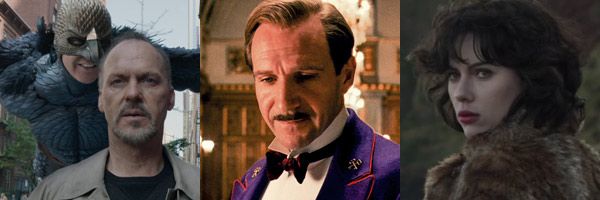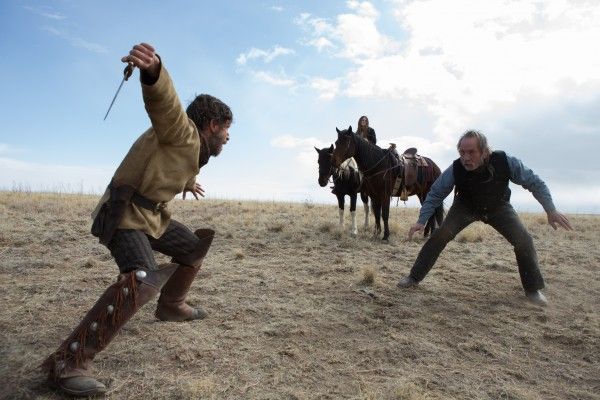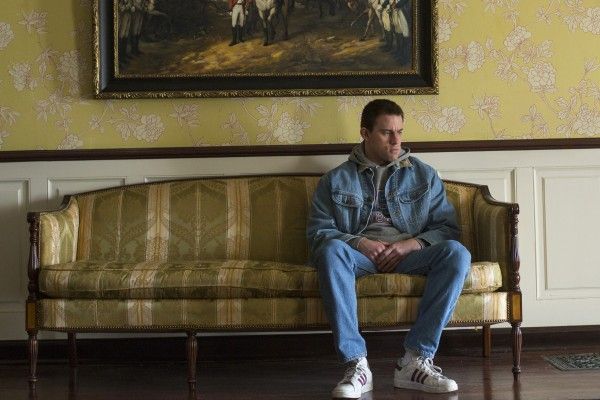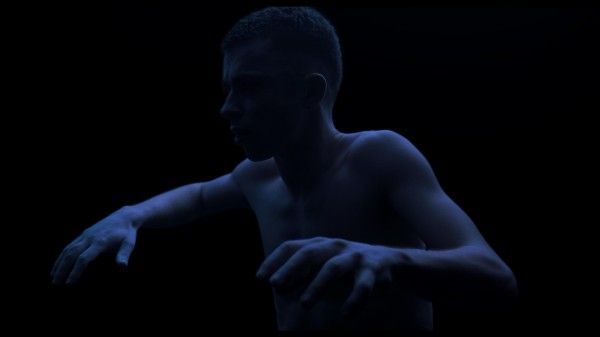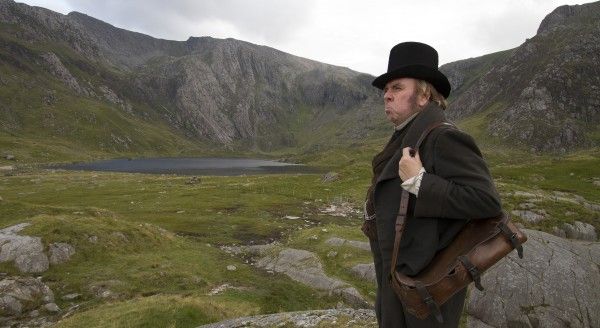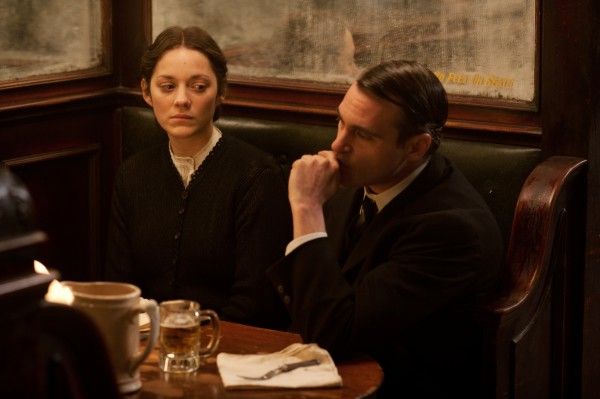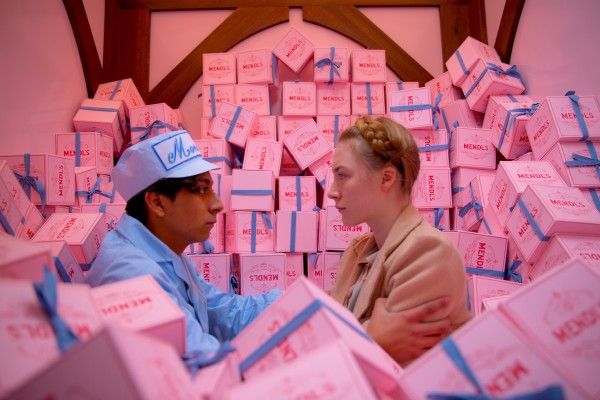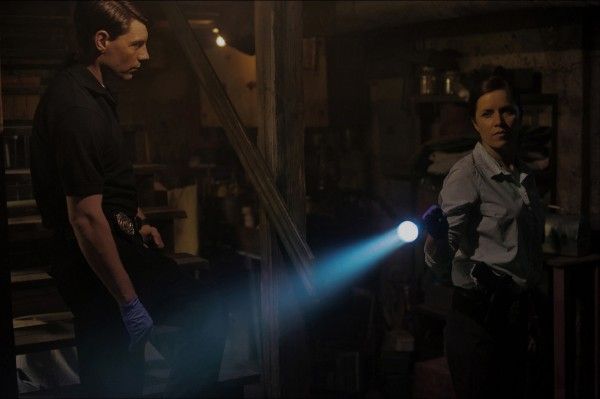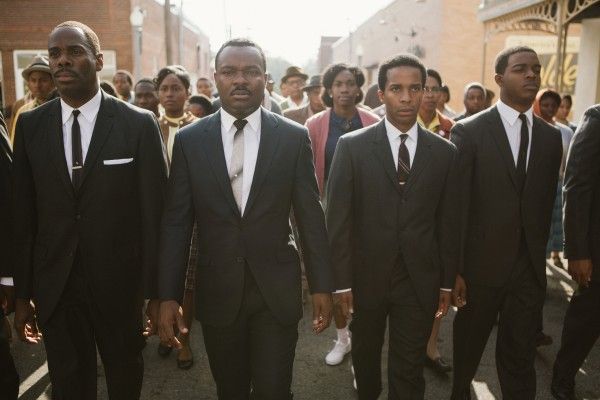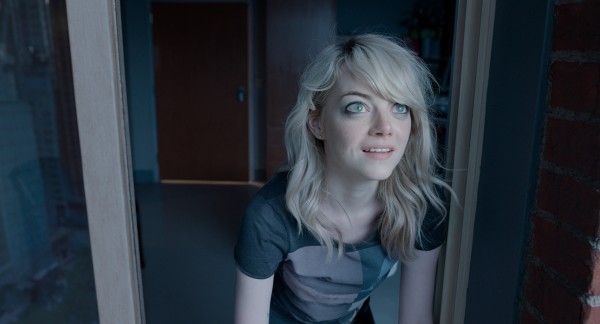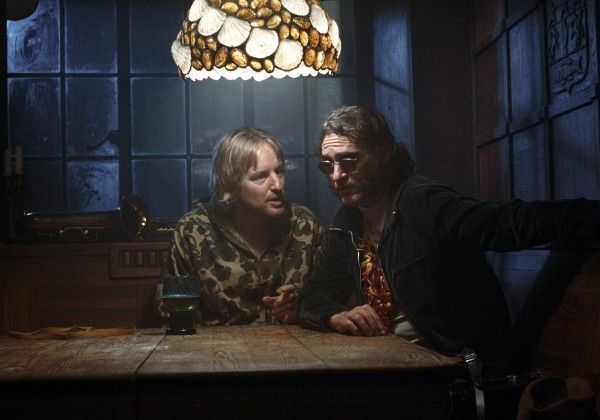The unsung heroes of the filmmaking world are the cinematographers. While the director sets the tone and certainly executes a very specific vision for a film, it’s the cinematographer who makes the visuals a reality. Just as there are very different directors, there are also very different cinematographers, and this year’s cinematic output gave us a series of wildly diverse—and impactful—images. There were so many notable pieces of cinematography in 2014 that it was hard to narrow it down to a list of just 10, but after the jump I’ve managed to single out the very best that the year in cinematography had to offer.
10. The Homesman – Rodrigo Prieto
Rodrigo Prieto has experience with the Western genre having lensed Brokeback Mountain, but for director Tommy Lee Jones’ consistently surprising The Homesman, he offers something quite different. The landscapes are gorgeous, of course, but Prieto makes interesting choices when it comes to framing Hilary Swank’s lonely, titular character, and the Midwest winter setting gives the film a unique palette as far as Westerns are concerned. It’s an odd, haunting film, and Prieto’s cinematography matches the fascinating tone that Jones hits upon for the female-centric drama.
9. Foxcatcher – Greig Fraser
Director Bennett Miller’s drama Foxcatcher is one of the coldest, most chilling films of the year, and Greig Fraser’s stark cinematography aids in conveying the sadness that permeates the picture. The characters are often framed as isolated and cutoff from the outside world, and even when multiple characters are in the same room, the stark contrasts paint them as alone. It’s impressively subtle work that proves the versatility involved in the art of cinematography—not everything has to be “prettyâ€.
8. Under the Skin – Daniel Landin
Filmmaker Jonathan Glazer’s arresting sci-fi drama Under the Skin is a visually-driven film. There’s not much dialogue involved, and when major things happen onscreen, it’s not explicitly explained to the viewer what exactly is going on and why it matters. It’s more poetic or lyrical in nature, and thus cinematographer Daniel Landin’s work is absolutely essential. Not only did he and Glazer rig up a van with hidden cameras so that they could capture non-professional actors interacting with Scarlett Johansson, but they found a terrifying way to visualize Johansson’s seduction of various men. It’s unforgettable sequence after unforgettable sequence, and Landin and Glazer walk the thin line between beauty and oddity.
7. Mr. Turner – Dick Pope
When tackling the subject of painter J.M.W. Turner, it’s tough to create a visual palette that matches the majesty and whimsy of the artist’s work. But somehow, by some miracle, cinematographer Dick Pope actually manages to make certain portions of Mr. Turner evoke a genuine Turner painting. It’s jaw-dropping, really, and I couldn’t believe it when I learned that there was zero CGI involved in the landscape shots—it’s all in camera. The film itself is so gorgeously crafted by Pope and director Mike Leigh that it could reasonably be considered a portrait all its own.
6. The Immigrant – Darius Khondji
Darius Khondji has been doing incredible work for years, and The Immigrant is no different, with one shot in particular destined to go into the Cinematography Hall of Fame. Khondji brings the world of 1920s New York to life through the eyes of Marion Cotillard’s Polish immigrant. The film is textured and moody, and yet also somewhat alluring—it’s nearly dreamlike at times. The cinematography goes hand-in-hand with the emotional draw of the film, and did I mention that incredible final shot?
Continue Reading the Best Cinematography of 2014 on Page 2Â
5. The Grand Budapest Hotel – Robert D. Yeoman
The partnership between Wes Anderson and cinematographer Robert D. Yeoman goes all the way back to Anderson’s feature debut, Bottle Rocket, and with their latest collaboration they may have turned out their most immaculately crafted film yet. The movie’s Russian nesting doll structure is mirrored in its cinematography, as Anderson and Yeoman present the film in three different aspect ratios, each with a distinct color palette. The results are simply exquisite, and I’m left wondering how the two can possibly top themselves.Â
4. Gone Girl – Jeff Cronenweth
As the debate over film versus digital rages on, David Fincher continues to master the latter format. He and Jeff Cronenweth have been working together on and off for years, but Gone Girl marks their third collaboration in a row and the photography is absolutely stunning. Shot entirely in 6K, the film is masterfully crafted using all of the best tools available for digital without ever feeling cheap or video-esque. The picture’s twisted structure is mirrored in the cinematography, as the early scenes between Nick and Amy are light and airy in contrast with the moody, foreboding present day-set sequences, giving the former an almost unrealistic feeling. And then the scenes with Nick himself, alone in their big house, are shot as if the character is imprisoned, echoing his isolation. Never have the Missouri suburbs felt so dark and treacherous.Â
3. Selma – Bradford Young
Between Selma and A Most Violent Year, cinematographer Bradford Young is having a banner year. The films couldn’t be more different from each other, and Young shows off his versatility with both while also maintaining a distinct voice. The cinematography in each film is incredible, but it’s Selma where Young’s talents coalesce into something immensely powerful. In concert with director Ava DuVernay, he paints the Civil Rights march in a modern context, opting not to shoot the film like a biopic and instead make it feel somewhat timeless. The use of handheld and the frequent framing of Dr. King from behind turn the film into a visceral experience, and the Edmund Pettus Bridge sequence is a brilliantly crafted, unforgettable piece of filmmaking.
2. Birdman – Emmanuel Lubezki
When Emmanuel Lubzeki shoots a movie, you know it’s going to be a ride. He’s right up there with Roger Deakins as one of the Greats, and he’s always game for a challenge. While we thought his work in last year’s Gravity was spectacular, “Chivo†somehow found a way to make his job even more arduous with the comedy Birdman. The idea: to make the film look as if it’s all one long take. That’s no easy task in and of itself, and while Lubezki found ways to hide cuts in pans across a wall or towards a door, his toughest and most impressive task came in lighting the various locations. Lighting one shot is hard enough, but Chivo is able to weave his camera around 360 degrees and maintain a consistent visual tone. This is incredibly tough to pull off, and he does so with grace—not to mention the rhythm with which he carries the movie from one scene to the next. It's yet another towering accomplishment from the cinematographer.
1. Inherent Vice – Robert Elswit
And yet, for all of Birdman’s bells and whistles, I found myself most transfixed this year by Robert Elswit’s work in Inherent Vice. It almost feels somewhat overlooked, as we all expect Elswit to capture incredible images in a Paul Thomas Anderson film. But given the movie’s aim to suck viewers into a hypnotic daze for 2+ hours, Elswit’s cinematography is absolutely crucial to pulling the magic trick off. And he does so exceptionally. He offers a unique look at the world of 1970 Los Angeles, a city stuck between two incredibly different times/cultures/generations, trying to find its footing. There are, of course, a number of memorable long takes, but it’s mostly the atmosphere that Elswit conjures that leaves the biggest impression. It’s like a noir, but not quite. Inherent Vice is its own special breed of…thing, Doc Sportello is our guide, and Elswit’s cinematography gently lowers us into the haze.
Honorable Mentions: Fury (Roman Vasyanov), Wild (Yves Bélanger), Calvary (Larry Smith)
For more of our Best of 2014 coverage, peruse the links below:
Movies
- Adam's Top 10 Films of 2014
- The Top 10 Scores of 2014
- 10 Best Surprises of 2014, From Emily Blunt as an Action Star to THE LEGO MOVIE Not Sucking
- 5 Great Film and Music Moments From 2014
- 10 Great Films of 2014 You May Have Missed and You Should Absolutely Watch
- Oscar Beat: For Your Consideration – Overlooked Films, Performances, and Directors from 2014 That Warrant Recognition
TV
- Comicbook Countdown: The Best Comic Book Shows of 2014 Including ARROW, THE FLASH, CONSTANTINE, GOTHAM, S.H.I.E.L.D., and THE WALKING DEAD
- 10 Best TV Episodes of the Season Thus Far
- Allison’s Other TV Bests of 2014
- Allison’s Top 12 Returning TV Series of 2014
- Allison’s Top 12 New TV Series of 2014

